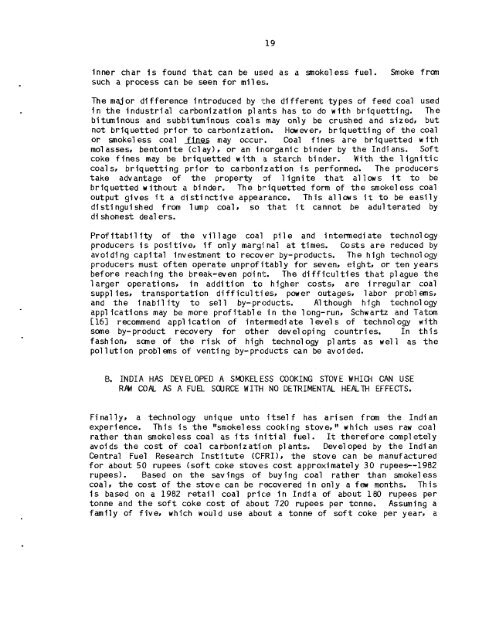Prospects for Coal Briquettes as a Substitute Fuel for Wood and ...
Prospects for Coal Briquettes as a Substitute Fuel for Wood and ...
Prospects for Coal Briquettes as a Substitute Fuel for Wood and ...
You also want an ePaper? Increase the reach of your titles
YUMPU automatically turns print PDFs into web optimized ePapers that Google loves.
19<br />
inner char is found that can be used <strong>as</strong> a smokeless fuel.<br />
such a process can be seen <strong>for</strong> miles.<br />
Smoke frm<br />
The major difference introduced by -:he different types of feed coal used<br />
in the industrial carbonization plants h<strong>as</strong> to do with briquetting. The<br />
bituminous <strong>and</strong> subbltuminous coals may only be crushed <strong>and</strong> sized, but<br />
not briquetted prior to carbonlzation. Hwever, briquetting of the coal<br />
or smokeless coal .fines may occur. <strong>Coal</strong> fines are briquetted with<br />
mol<strong>as</strong>ses, bentonite (clay), or an inorganic binder by the Indians. Soft<br />
coke fines may be briquetted with a starch binder. With the lignitic<br />
coal sp briquetting prior to carbonization is per<strong>for</strong>med. The producers<br />
take advantage of the property of 1 ignite that allows it to be<br />
briquetted without a binder. The briquetted <strong>for</strong>m of the smokeless coal<br />
output gives it a distinctive appearance. This allows it to be e<strong>as</strong>ily<br />
distinguished from lump coalr so that it cannot be adulterated by<br />
di shonest deal ers.<br />
Profitability of the village coal pile <strong>and</strong> intermediate technology<br />
producers is positive, if only marginal at times. Costs are reduced by<br />
avoiding capital investment to recover by-products. The high technol ogy<br />
producers must often operate unprofitably <strong>for</strong> seven, eight, or ten years<br />
be<strong>for</strong>e reaching the break-even poi nt. The di ff icul ties that pl ague the<br />
larger operations, in addition to higher costs, are irregular coal<br />
suppl ies, transportation difficulties, power outages, labor probl cans$<br />
<strong>and</strong> the inabil ity to sell by-products. A1 though high technol ogy<br />
appl ications may be more prof itable in the long-run, Schwartz <strong>and</strong> Tatom<br />
C161 recommend appl ication of intermed-l ate 1 eve1 s of technol ogy with<br />
some by-product recovery <strong>for</strong> other developing countries. In this<br />
f<strong>as</strong>hion, sane of the risk of high technology plants <strong>as</strong> well <strong>as</strong> the<br />
pol 1 ution probl ems of vent? ng by-products can be avoided.<br />
B. INDIA HAS DEVELOPED A SMOKELESS COOKING STOVE WHICH CAN USE<br />
RAW COAL AS A FUEL SOURCE WITH NO DETRIMENTAL HEALTH EFFECTS.<br />
Finally, a technology unique unto itself h<strong>as</strong> arisen fran the Indian<br />
experience. Thls is the %smokeless cooking stove,'! which u5es raw coal<br />
rather than smokeless coal <strong>as</strong> its initial fuel. It there<strong>for</strong>e cmpletely<br />
avoids the cost of coal carbonization plants. Developed by the Indian<br />
Central <strong>Fuel</strong> Research Institute (CFRI), the stove can be manufactured<br />
<strong>for</strong> about 50 rupees (soft coke stoves cost approximately 30 rupee+--1982<br />
rupees). B<strong>as</strong>ed on the savings of buying coal rather than smokeless<br />
coal, the cost of the stove can be rfxovered in only a few months. This<br />
Is b<strong>as</strong>ed on a 1982 retail coal price in India of about 180 rupees per<br />
tonne <strong>and</strong> the soft coke cost of about 720 rupees per tonne. Assuming a<br />
family of five, which would use about a tonne of soft coke per year., a

















